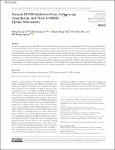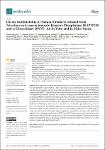Search
Author
- Manh-Hung Tran (2)
- Phi-Hung Nguyen (2)
- Thi-Thuy Do (2)
- Hong-Luyen Le (1)
- next >
Subject
- 2-NBDG (1)
- ?-glucosidase (3W37) (1)
- anthraquinone (1)
- glucose-uptake (1)
- next >
Date issued
Has File(s)
- true (2)
Search Results
Ten active principles (compounds 1-10) have been isolated following protein tyrosine phosphatase 1B (PTP1B) assay-guided fractionation of the methanol extract of the root of Polygonum cuspidatum. The chemical structures of the compounds were characterized mainly by nuclear magnetic resonance (NMR) spectroscopic and physicochemical data. This is the first time that 9,10-anthraquinones (compounds 5-6) have been isolated from P. cuspidatum, and this is the first record of compound 9 from the genus Polygonum. Except for compound 4, all the isolates showed potential inhibitory activity against PTP1B with half-maximal inhibitory concentration IC50 values ranging from 6.3 to 28.9 µM. Furthermore, a kinetic study indicated mixed-competitive inhibition with PTP1B for compounds 2 and 9 and no... |
Folk experiences suggest natural products in Tetradium ruticarpum can be effective inhibitors towards diabetes-related enzymes. The compounds were experimentally isolated, structurally elucidated, and tested in vitro for their inhibition effects on tyrosine phosphatase 1B (PTP1B) and ?-glucosidase (3W37). Density functional theory and molecular docking techniques were utilized as computational methods to predict the stability of the ligands and simulate interaction between the studied inhibitory agents and the targeted proteins. Structural elucidation identifies two natural products: 2-heptyl-1-methylquinolin-4-one (1) and 3-[4-(4-methylhydroxy-2-butenyloxy)-phenyl]-2-propenol (2). In vitro study shows that the compounds (1 and 2) possess high potentiality for the inhibition of PTP1... |


